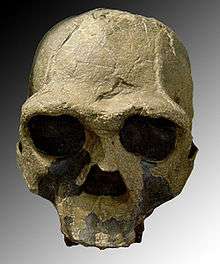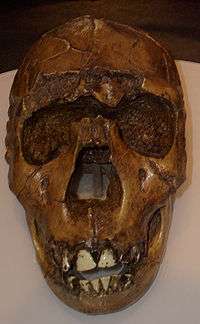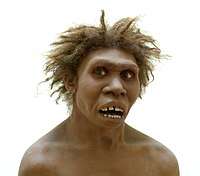Homo ergaster
| Homo ergaster | |
|---|---|
 | |
| KNM-ER 3733 (1.6 Million years ago, discovered 1975 at Koobi Fora, Kenya) | |
| Scientific classification | |
| Kingdom: | Animalia |
| Phylum: | Chordata |
| Class: | Mammalia |
| Order: | Primates |
| Suborder: | Haplorhini |
| Infraorder: | Simiiformes |
| Family: | Hominidae |
| Subfamily: | Homininae |
| Tribe: | Hominini |
| Genus: | Homo |
| Species: | †H. ergaster |
| Binomial name | |
| Homo ergaster | |
Homo ergaster , also Homo erectus ergaster[1] or African Homo erectus is an extinct chronospecies of the genus Homo that lived in eastern and southern Africa during the early Pleistocene, between about 1.9 million and 1.4 million years ago.
Originally proposed as a separate species, H. ergaster is now mostly considered either an early form, or an African variety, of H. erectus.[2][3][4]
The binomial name was published in 1975 by Groves and Mazák. The specific epithet, "ergaster", is derived from the Ancient Greek ἐργαστήρ ergastḗr - "workman", in reference to the advanced lithic technology developed by the species, thereby introducing the Acheulean industry.
KNM-ER 2598, a "H. erectus-like" occipital bone stands as the earliest evidence for H. erectus in Africa at approximately 1.9 million years ago (contemporary with Homo rudolfensis).[5] There is a fossil gap between 1.9 and 1.6 million years ago, KNM-ER 3733 is the oldest known H. ergaster skull dated to about 1.6 million years ago.[6] Its survival past 1.4 million years ago is uncertain, again due to a fossil gap, the next available African fossils allowing reliable morphological analysis are those of Homo rhodesiensis (African H. heidelbergensis), at 0.6 million years ago.
Discovery and representative fossils
South African palaeontologist John T. Robinson discovered in 1949 a mandible of a new hominin in southern Africa, which he named Telanthropus capensis and which today is classified as Homo ergaster.[7] That taxon was first applied to a mandible found near Lake Rudolf (now Lake Turkana), Kenya, by Colin Groves and Vratislav Mazák in 1975; dubbed KNM-ER 992, it became the type-specimen of the species. A near-complete skeleton of H. ergaster, KNM-WT 15000, or "Turkana Boy", was discovered in 1984 at Lake Turkana by Kamoya Kimeu and Alan Walker. It is dated to 1.6 million years ago (mya) and is one of the most complete early hominin fossils found to date.
Classification


Although "Homo ergaster" has gained some acceptance as a valid taxon since its proposal in 1975, ergaster and erectus since the 1980s have increasingly come to be seen as separate (that is, African or Asian) populations of the larger species H. erectus. Some consider H. ergaster to be a variety of H. erectus ("African Homo erectus") that migrated out of Africa, branching into various Eurasian subspecies. In this scenario, the labels "Homo erectus sensu stricto" (strict sense) refers to the Eurasian varieties and "Homo erectus sensu lato" (broad sense) for the greater species comprising both Asian and African populations. [8] The notation "Homo erectus/ergaster" was also used to express the uncertainty on whether the two designations should be considered synonyms.[9] The question was described as "famously unresolved" as of 2003.[10] Sura et al (2007) concluded that Homo erectus "was a likely source of multiple events of gene flow to the Eurasian continent".[11]
The discoveries of the Dmanisi skulls in the South Caucasus since 2005 have re-opened this question. Their great morphological diversity suggests that the variability of Eurasian H. erectus already includes the African fossils dubbed H. ergaster. The discovery of Dmanisi skull 5 in 2013, dated to 1.8 million years ago, now dates evidence of H. erectus in Eurasia as of virtually the same age as evidence for H. ergaster in Africa, so that it is unclear if the speciation of H. erectus/ergaster from H. habilis took place in Africa or Asia.[12] This has reinforced the trend of considering H. ergaster as synonymous with H. erectus, a species which would have evolved just after 2 million years ago, either in Africa or West Asia, and later dispersed throughout Africa and Eurasia.[13][14]
Even before the discoveries at Dmanisi there was broad concern about the amount of speciation as a norm described throughout the course of human evolution. A question was raised as to whether the number of taxa within the genus Homo had been seriously overstated.[15]
H. ergaster may be distinguished from H. erectus by its thinner skull-bones and lack of an obvious supraorbital foramen, and from H. heidelbergensis by its thinner bones, more protrusive face, and lower forehead. Derived features separating it from earlier non-Homo species include reduced sexual dimorphism,[16] a smaller, more orthognathous (less protrusive) face, a smaller dental arcade, and a larger cranial capacity (that is, 700–900 cm³ in earlier H. ergaster-specimens, and 900–1100 in later specimens).[9] Remains have been found in Tanzania, Ethiopia, Kenya, and South Africa.
H. erectus/ergaster (H. erectus sensu lato) is the predecessor of Homo heidelbergensis (in Africa also known as Homo rhodesiensis), which arose after about 0.8 million years ago. Late populations of morphological H. erectus were mostly replaced by H. heidelbergensis by 0.5 million years ago. Homo neanderthalensis and Homo sapiens are in turn derived from H. heidelbergensis at about 0.3 million years ago.[17]
Derivation and extinction
There are broad divisions in the scientific community re interpreting the development of the earliest species of genus Homo. H. habilis is generally accepted as the putative ancestor of Homo,[7] and the direct ancestor of H. ergaster. However, habilis's status as a legitimate species within "Homo" is particularly contentious. Apparently, habilis and ergaster coexisted in East Africa for almost half a million years, which likely indicates that, rather than an anagenetic connection between them, they diverged from a common ancestor.[18][19]
The derivation of H. erectus (H. ergaster) from Homo habilis is thought to have taken place shortly after two million years ago. By 1.8 million years ago, both African (H. ergaster) and Asian (H. erectus georgicus) variants were present.[8] These early descendants of H. habilis may have been discovered at Dmanisi, Georgia as '.[20]
H. ergaster remained in Africa for about 500,000 years before disappearing from the fossil record after 1.4 million years ago; no identifiable cause has been attributed to the disappearance. The much-later evidence of the derived Homo heidelbergensis in the same region may indicate a gap in the fossil record, with intermediate variants of the period 1.4 to 0.6 million years ago still to be discovered.
Use of tools
H. ergaster used more diverse and sophisticated stone tools than its predecessor, H. habilis. H. ergaster refined the inherited Oldowan technology, then developed the first Acheulean bifacial axes.[21] While the use of Acheulean tools began ca. 1.6 million years ago, the line of H. erectus diverged some 200,000 years before the general innovation of Acheulean technology.
Sociality
Sexual dimorphism in H. ergaster is greatly reduced from its australopithecine ancestors (around 20%),[16] but still is greater than the dimorphism in modern humans. Diminished dimorphism is speculated to be a sign of reduced competition for mates between males.[22]
Not only was H. ergaster like modern humans in body, but also more in organisation and sociality than any earlier species. It is conceivable that H. ergaster was the first hominin to harness fire: whether as the containment of natural fire, or as the lighting of artificial fire, is still a matter of contention. It is now assumed that H. erectus did have control of fire,[23] as did every other hominin sharing a common ancestor with H. ergaster.
Use of language
Based on Turkana Boy's cervical vertebrae, which were far narrower than in later humans, it was thought that H. ergaster was restricted in the physical ability to regulate breathing and thereby to produce complex sounds. Later finds, however, disclosed that cervical vertebrae in Dmanisi, which are some 300,000 years older than those of Turkana Boy, were well within the normal range of human vertebrae.[24] And it has been established that the Turkana Boy probably suffered from a disease of the spinal column that resulted in narrower cervical vertebrae than in modern humans[25] (or in the older Dmanisi finds). While the Dmanisi finds have not been established definitively as H. ergaster, they are older than Turkana Boy (the only definitive H. ergaster vertebrae on record), thereby suggesting kinship to H. ergaster.
See also
General:
Footnotes
- ↑ Noel T. Boaz, Russell L. Ciochon, Dragon Bone Hill: An Ice-Age Saga of Homo erectus, Oxford University Press (2004).
- ↑ "Homo ergaster – Many researchers deny any validity to the species at all. On the whole though, most researchers see too little difference between ergaster and erectus to form the basis of a species of the former, separated from the latter". ArchaeologyInfo.com. Retrieved 30 October 2015.
- ↑ Hazarika, Manjil. "Homo erectus/ergaster and Out of Africa: Recent Developments in Paleoanthropology and Prehistoric Archaeology" (PDF). Universitat Rovira i Virgili, Tarragona, Spain. Retrieved 26 December 2015.
- ↑ "An Overview of the Siwalik Acheulian & Reconsidering Its Chronological Relationship with the Soanian – A Theoretical Perspective". Research School of Archaeology and Archaeological Sciences University of Sheffield. Archived from the original on 4 January 2012. Retrieved 26 December 2015.
- ↑ William H. Kimbel, Brian Villmoare, "From Australopithecus to Homo: the transition that wasn't", Philosophical Transactions of the Royal Society B, 13 June 2016, DOI: 10.1098/rstb.2015.0248.
- ↑ Lepre CJ, Kent DV, "Chronostratigraphy of KNM-ER 3733 and other Area 104 hominins from Koobi Fora" , J Hum Evol. 2015 Sep; 86:99-111. doi: 10.1016/j.jhevol.2015.06.010.
- 1 2 Wood, Bernard, and Mark Collard (2001). "The Meaning of Homo". Ludus Vitalis. 9 (15): 63–74.
- 1 2 Tattersall, Ian and Jeffrey Schwartz (2001). Extinct Humans. Boulder, Colorado: Westview/Perseus. ISBN 978-0-8133-3482-0.
- 1 2 Hazarika, Manji (16–30 June 2007). "Homo erectus/ergaster and Out of Africa: Recent Developments in Paleoanthropology and Prehistoric Archaeology".
- ↑ "The H. ergaster question remains famously unresolved" Antón, S. C. (2003). "Natural history of Homo erectus". Am. J. Phys. Anthropol. 122: 126–170. doi:10.1002/ajpa.10399. PMID 14666536.
By the 1980s, the growing numbers of H. erectus specimens, particularly in Africa, led to the realization that Asian H. erectus (H. erectus sensu stricto), once thought so primitive, was in fact more derived than its African counterparts. These morphological differences were interpreted by some as evidence that more than one species might be included in H. erectus sensu lato (e.g., Stringer, 1984; Andrews, 1984; Tattersall, 1986; Wood, 1984, 1991a, b; Schwartz and Tattersall, 2000) ... Unlike the European lineage, in my opinion, the taxonomic issues surrounding Asian vs. African H. erectus are more intractable. The issue was most pointedly addressed with the naming of "H. ergaster" on the basis of the type mandible KNM-ER 992, but also including the partial skeleton and isolated teeth of KNM-ER 803 among other Koobi Fora remains (Groves and Mazak, 1975). Recently, this specific name was applied to most early African and Georgian H. erectus in recognition of the less-derived nature of these remains vis à vis conditions in Asian H. erectus (see Wood, 1991a, p. 268; Gabunia et al., 2000a). It should be noted, however, that at least portions of the paratype of " H. ergaster " (e.g., KNM-ER 1805) are not included in most current conceptions of that taxon. The " H. ergaster " question remains famously unresolved (e.g., Stringer, 1984; Tattersall, 1986; Wood, 1991a, 1994; Rightmire, 1998b; Gabunia et al., 2000a; Schwartz and Tattersall, 2000), in no small part because the original diagnosis provided no comparison with the Asian fossil record
- ↑ Suwa G, Asfaw B, Haile-Selassie Y, White T, Katoh S, WoldeGabriel G, Hart W, Nakaya H, Beyene Y (2007). "Early Pleistocene Homo erectus fossils from Konso, southern Ethiopia". Anthropological Science. 115 (2): 133–151. doi:10.1537/ase.061203.
- ↑ Bernard Wood, "Did early Homomigrate 'out of' or 'in to' Africa?", PNAS vol. 108, no.26 (28 June 2011), 10375–10376.
- ↑ Rightmire, G. P.; Lordkipanidze, D.; Vekua, A. (2006). "Anatomical descriptions, comparative studies and evolutionary significance of the hominin skulls from Dmanisi, Republic of Georgia". Journal of Human Evolution. 50 (2): 115–141. doi:10.1016/j.jhevol.2005.07.009. PMID 16271745.
- ↑ Gabunia, L.; Vekua, A.; Lordkipanidze, D.; Swisher Cc, 3.; Ferring, R.; Justus, A.; Nioradze, M.; Tvalchrelidze, M.; Antón, S. C.; Bosinski, G.; Jöris, O.; Lumley, M. A.; Majsuradze, G.; Mouskhelishvili, A. (2000). "Earliest Pleistocene hominid cranial remains from Dmanisi, Republic of Georgia: Taxonomy, geological setting, and age". Science. 288 (5468): 1019–1025. Bibcode:2000Sci...288.1019G. doi:10.1126/science.288.5468.1019. PMID 10807567.
- ↑ Kramer, A (1993). "Human Taxonomic Diversity in the Pleistocene: Does Homo erectus Represent Multiple Hominid Species?". American Journal of Physical Anthropology. 91 (2): 161–171. doi:10.1002/ajpa.1330910203. PMID 8317558.
- 1 2 McHenry, Henry M. (1994). "Behavioral ecological implications of early hominid body size". Academic Press Limited.
- ↑ G. Philip Rightmire (1998). "Human Evolution in the Middle Pleistocene: The Role of Homo heidelbergensis". Evolutionary Anthropology. 6 (6): 218–227. doi:10.1002/(sici)1520-6505(1998)6:6<218::aid-evan4>3.0.co;2-6.
- ↑ F. Spoor; M. G. Leakey; P. N. Gathogo; F. H. Brown; S. C. Antón; I. McDougall; C. Kiarie; F. K. Manthi; L. N. Leakey (9 August 2007). "Implications of new early Homo fossils from Ileret, east of Lake Turkana, Kenya". Nature. 448 (7154): 688–691. Bibcode:2007Natur.448..688S. doi:10.1038/nature05986. PMID 17687323. (1) "A partial maxilla assigned to H. habilis reliably demonstrates that this species survived until later than previously recognized, making an anagenetic relationship with H. erectus unlikely." (2) "... these two early taxa were living broadly sympatrically in the same lake basin for almost half a million years." (Emphasis added).
- ↑ Urquhart, James (8 August 2007). Finds Test Human Origins Theory.
- ↑ Tattersall, Ian (2008). "An Evolutionary Frameworks for the Acquisition of Symbolic Cognition by Homo sapiens".
- ↑ Beck, Roger B.; Black, Linda; Krieger, Larry S.; Naylor, Phillip C.; Shabaka, Dahia Ibo (1999). World History: Patterns of Interaction. Evanston, IL: McDougal Littell. ISBN 978-0-395-87274-1.
- ↑ Gray, Peter B. (2010). "The Evolution and Endocrinology of Human Behavior: a Focus on Sex Differences and Reproduction". Cambridge, UK: Cambridge University Press. pp. 277–292. ISBN 978-0-521-70510-3.
- ↑ Goren-Inbar, Naama; Alperson, N; Kislev, ME; Simchoni, O; Melamed, Y; Ben-Nun, A; Werker, E; et al. (30 April 2004). "Evidence of Hominin Control of Fire at Gesher Benot Ya 'aqov, Israel". Science. 304 (5671): 725–727. Bibcode:2004Sci...304..725G. doi:10.1126/science.1095443. PMID 15118160.
- ↑ Bruce Bower (6 May 2006). "Evolutionary Back Story: Thoroughly Modern Spine Supported Human Ancestor". Science News Online. 169 (18): 275. doi:10.2307/4019325. JSTOR 4019325.
- ↑ Wong, Kate (November 2003). "Stranger in a new land". Scientific American. 289 (5): 74–83. Bibcode:2003SciAm.289e..74W. doi:10.1038/scientificamerican1103-74. PMID 14564816.
References
- Deacon, Terrence W. (1998). The Symbolic Species: The Co-evolution of Language and the Brain. W.W. Norton & Company. ISBN 978-0-393-03838-5.
- Leakey, Richard (1 September 1992). Origins Reconsidered. ISBN 978-0-385-41264-3.
- Ruhlen, Merritt (1994). The origin of language: tracing the evolution of the mother tongue. New York: Wiley. ISBN 978-0-471-58426-1.
- Shreeve, James (1995). The Neandertal Enigma: Solving the Mystery of Modern Human Origins. Harper Perennial. ISBN 978-0-670-86638-0.
- Tattersall, Ian; Jeffrey Schwartz (2000). Extinct Humans. Boulder and Cumnor Hill: Westview Press. ISBN 978-0-8133-3482-0.
- Wood, Bernard; Mark Collard (2001). "The Meaning of Homo". Ludus Vitalis. 9.
External links
| Wikimedia Commons has media related to Homo ergaster. |
- Archaeology Info
- Smithsonian
- Homo ergaster Origins – Exploring the Fossil Record – Bradshaw Foundation
- Controversial Human Ancestor Gets Major Facelift
- Human origins family tree
- Human Timeline (Interactive) – Smithsonian, National Museum of Natural History (August 2016).